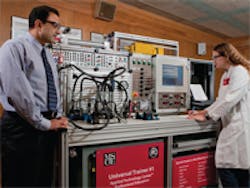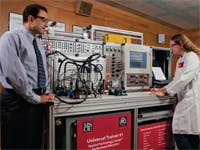MSOE Completes Fluid Power Trainer Prototype
After six months of design and development, a new state-of-theart fluid power and motion control training unit has been manufactured for use at the Milwaukee School of Engineering.
Medhat Khalil, Ph.D, Director of Professional Education at MSOE, designed and virtually built the unit in Solid Works, setting all specifications, selecting the components, and proposing the layout and integrity of the subsystems. A third-party local manufacturer assembled the system.
The Universal Transportable Fluid Power Trainer is a prototype that will be used in advanced courses until it at least six more are duplicated, says Khalil.
The machine has been designed to be universal, smart, transportable, and compact so it can be used easily at both the college and at a customer’s facility for professional education programs. The design of the prototype has been funded by the Center for Compact & Efficient Fluid Power, a National Science Foundation Engineering Research Center.
The design of this system can be used by other educators or professionals in the industry, says Khalil. “We are open to negotiate building similar units or even customize units for other educational institutions,” he said. “We are also open to share our expertise to design hydraulic power units, test stands, and design simulation software for hydraulic systems.”
The machine is transportable, featuring a wheeled frame and component carrying cases, with just one frame holding all components. The components are industrial grade, brand non-biased, and are connected by ISO interchange quick disconnects.
The unit can cover the following disciplines: hydraulics, electrohydraulics, pneumatics, electro-pneumatics, and electro-mechanical. Training can be completed for basic to advanced level courses, including standard or tailored courses, in both industrial and mobile applications.
The system’s controlled axes are both linear and rotary. Parameters that can be controlled with the machine include linear and angular position, linear and angular velocity, and flow, pressure, force, and torque. Its smart technical capabilities include:
• PC-based control and condition monitoring through an HMI,
• Choice of system of English or Metric units of measure,
• Variable pump displacement,
• Flexible and interactive pump control mode of the user’s choice,
• Variable setting of the maximum working pressure and/or temperature,
• Warnings delivered if set values of working temperature, cavitation, oil level and filter clogging are exceeded,
• Automated sub-systems test wizard,
• Smart maintenance: maintenance calendar, documentation, and how to do it, and
• Ability to build multidisciplinarysystems (Electro-Hydro-Pneumatic).
For more information, contact Dr. Medhat Khalil at MSOE at (414) 277-7269, or [email protected].
About the Author

Leaders relevant to this article:

